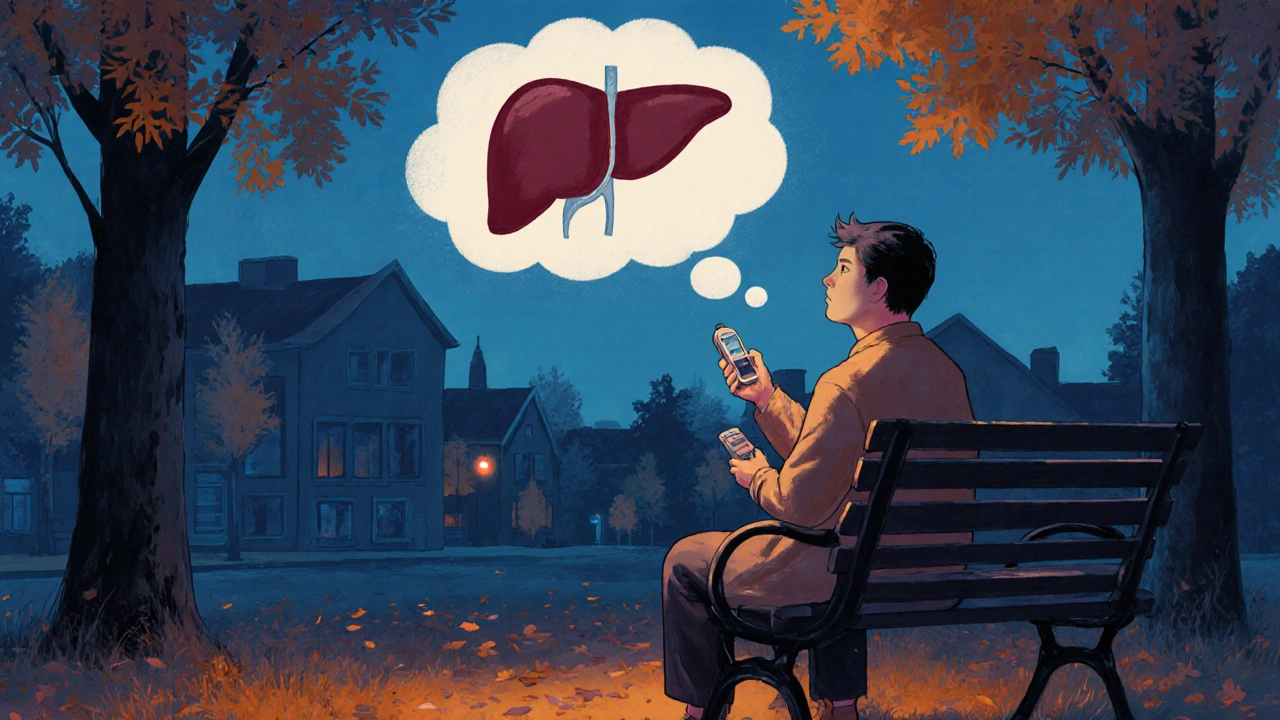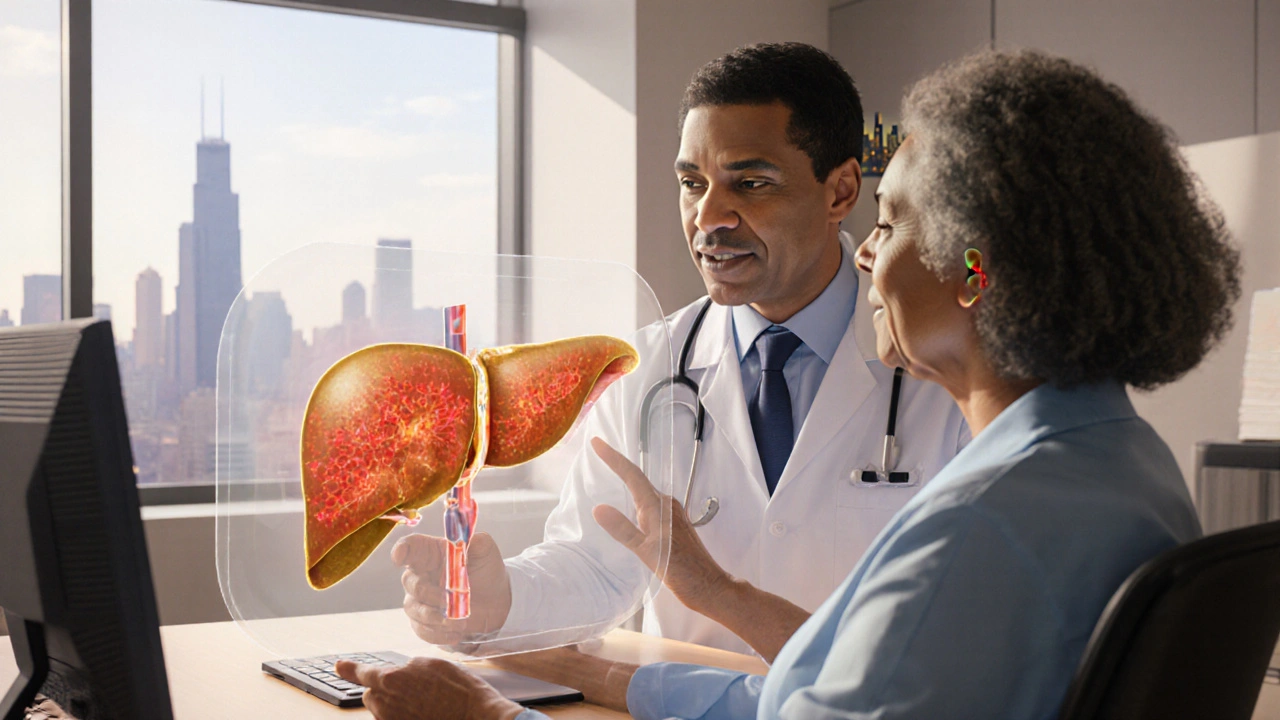Hepatitis C is a viral infection caused by the Hepatitis C virus (HCV) that primarily targets the liver. Over decades, untreated infection can lead to a cascade of health problems, from cirrhosis to heart disease. This guide walks through the most common long‑term effects, how they develop, and what modern treatment means for your future.
Why the Liver Takes a Hit Over Time
When HCV enters the bloodstream, it settles in liver cells (hepatocytes) and begins a slow battle. The immune response creates inflammation, which triggers scar tissue formation-known as fibrosis. Over 20‑30 years, fibrosis can progress to Liver Cirrhosis, a condition where normal tissue is replaced by stiff, non‑functional scar tissue.
Key markers of progression include:
- Elevated ALT/AST enzymes indicating ongoing liver injury.
- Fibrosis stageF3‑F4 on elastography or biopsy.
- Reduced platelet count, a sign of portal hypertension.
Once cirrhosis sets in, the liver’s ability to filter toxins, produce clotting factors, and store nutrients is compromised, laying the groundwork for other serious ailments.
Hepatocellular Carcinoma: Cancer Risk Grows
Chronic HCV infection is the leading cause of Hepatocellular Carcinoma (HCC) in the world. Studies from the World Health Organization estimate that 1‑4% of cirrhotic patients develop HCC each year. The risk climbs dramatically when:
- Alcohol consumption exceeds moderate levels.
- Co‑infection with hepatitis B or HIV is present.
- Diabetes or obesity adds metabolic stress.
Regular ultrasound screening combined with alpha‑fetoprotein (AFP) testing is recommended for anyone with HCV‑related cirrhosis, catching tumors when curative options like resection or ablation are still possible.
Extrahepatic Manifestations: The Body’s Ripple Effect
HCV isn’t confined to the liver. The virus can trigger immune complexes and metabolic disturbances that affect other organs. Below are the most frequent extrahepatic complications.
- Cryoglobulinemia: Cold‑sensitive antibodies cause vasculitis, leading to skin ulcers, joint pain, and kidney inflammation.
- Insulin Resistance and type2 diabetes: HCV interferes with insulin signaling, increasing diabetes risk by up to 50% compared with uninfected peers.
- Chronic kidney disease: Immune complex deposition in glomeruli can progress to end‑stage renal disease, especially in patients with cryoglobulinemia.
- Cardiovascular Disease: Inflammation stiffens arteries, raising heart‑attack and stroke odds by roughly 30%.
- Mental health issues: Persistent fatigue, stigma, and cytokine‑driven neuroinflammation contribute to depression and anxiety in up to 40% of chronic HCV patients.
These manifestations often appear before liver damage becomes obvious, making a thorough systemic evaluation essential.
Living with Chronic Fatigue and Reduced Quality of Life
Even without overt organ damage, many people report constant tiredness, muscle aches, and brain fog. A 2022 cohort study from the European Liver Institute found that 65% of untreated HCV patients scored poorly on the SF‑36 quality‑of‑life survey, particularly in the vitality and mental health domains.
Addressing these symptoms includes:
- Tailored exercise programs to improve stamina.
- Cognitive‑behavioral therapy for mood disorders.
- Nutrition counseling focusing on protein‑rich foods to support liver regeneration.

How Direct‑Acting Antivirals (DAAs) Change the Landscape
Since 2014, Direct‑Acting Antiviral (DAA) regimens have pushed cure rates above 95% across all genotypes, with treatment courses as short as eight weeks. Achieving a sustained virologic response (SVR) essentially means the virus is undetectable a year after therapy.
Long‑term studies show that curing HCV dramatically reduces the odds of:
- Progression to cirrhosis (by ~70%).
- Developing HCC (by ~50% in non‑cirrhotic patients).
- Extrahepatic complications such as cryoglobulinemic vasculitis and insulin resistance.
However, patients with pre‑existing cirrhosis still require ongoing surveillance because scar tissue does not disappear after the virus is cleared.
Monitoring After Cure: What to Keep an Eye On
Even after an SVR, doctors recommend a structured follow‑up plan:
- Six‑month liver imaging (ultrasound) for patients with advanced fibrosis.
- Annual AFP testing if cirrhosis was present.
- Renal function labs every 12months for those with prior cryoglobulinemia.
- Metabolic screening (fasting glucose, lipid profile) to catch emerging diabetes.
Lifestyle tweaks-limiting alcohol, maintaining a healthy weight, and staying vaccinated against hepatitisA andB-further safeguard long‑term health.
Comparison of Complication Risks: Untreated vs. Cured
| Complication | Untreated (10‑yr risk) | After SVR (10‑yr risk) |
|---|---|---|
| Advanced fibrosis / cirrhosis | 30‑40% | 8‑12% |
| Hepatocellular carcinoma | 5‑7% | 1‑2% |
| Cryoglobulinemic vasculitis | 10‑12% | 2‑3% |
| Type 2 diabetes | 18‑22% | 9‑11% |
| Cardiovascular events | 15‑18% | 7‑9% |
These numbers, drawn from longitudinal cohorts in North America and Europe, underline the tangible health gains from clearing the virus.
Take‑away Checklist
- Get tested for HCV if you have risk factors (e.g., IV drug use, blood transfusion before 1992).
- If positive, discuss DAA therapy-cure rates exceed 95%.
- Even after cure, maintain regular liver imaging if you had advanced fibrosis.
- Monitor for diabetes, kidney disease, and mental‑health changes.
- Adopt a liver‑friendly lifestyle: low alcohol, balanced diet, exercise.

Frequently Asked Questions
Can I still develop liver cancer after I’m cured of Hepatitis C?
Yes, especially if you had cirrhosis before treatment. The risk drops significantly, but surveillance with ultrasound and AFP every six months remains recommended for at‑least five years after cure.
Do DAAs cure the extrahepatic symptoms like cryoglobulinemia?
In most cases, yes. Clearing the virus reduces immune‑complex formation, leading to symptom remission in 70‑80% of patients. Those with severe vasculitis may still need immunosuppressive therapy.
How often should I have liver scans after achieving SVR?
If you never developed advanced fibrosis, a single post‑treatment scan is enough. With F3‑F4 fibrosis or cirrhosis, continue ultrasound every six months for at least a decade.
Is there any chance of getting reinfected after a cure?
Reinfection is possible if you’re exposed again (e.g., sharing needles). Maintaining harm‑reduction practices and vaccination against hepatitisA andB are the best defenses.
What lifestyle changes help protect my liver after cure?
Limit alcohol to less than 14units per week, follow a Mediterranean‑style diet rich in fruits, vegetables, and omega‑3 fatty acids, keep a healthy weight, and exercise at least 150minutes a week.
Do I need to tell my doctor about past Hepatitis C if I’m pregnant?
Absolutely. Even after cure, a history of HCV prompts closer monitoring of liver function during pregnancy, and your baby may need hepatitisC testing after birth.
